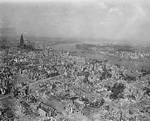The Cologne History Began Already 50 A.D. ...
The Cologne history started more than 2,000 years ago, when the first Romans came to this Rhine area.
When Cologne became city in 50 A.D., it beared the name Colonia Claudia Ara Agrippinensium (CCAA) because of the Roman Empress Agrippina. That set the starting point of the "nothern Rome" and the Cologne history.
Cologne had a bishop as early as 313, and, in 785, became the seat of an archbishop. The Archbishop of Cologne was one of the seven Electors of the Holy Roman Empire. He ruled a large area as a secular lord in the Middle Ages, but in 1288, he was defeated by the Cologne citizens and forced to move to Bonn. The city was a member of the Hanseatic League and became a free city officially by 1475.
Cologne lost its free status, and regained its archbishopric during the French period. In 1815, at the Congress of Vienna was made part of the kingdom of Prussia. Cologne became an industrial city.
Another dot in the Cologne history was the start of building of Cologne Cathedral, which was in 1248. It was abandoned in the mid-1500s, and finished in 1880. 632 years construction period. Think about that...
During the 19th and 20th century, Cologne incorporated numerous surrounding towns, and by the time of World War 1 had already 600,000 inhabitants.
A sad dot in the Cologne history was World War 2, when the city was repeatedly bombed. Cologne was in ruins (see picture on right hand side). It took some time to rebuild the city, but afterwards it grew again.
Since 1975, the population of Cologne Germany always lies around 1 million inhabitants.
So much the Rhine of the city brought prosperity and quality of life in the Cologne history, so feared is its flood. The current water level can be read off from the "clock" of Cologne water level at Rhine Promenades.
The worst flood ever registered occurred in February 1784, when after an extremely long and cold winter a temperature jump happened. The Rhine river had frozen over at this time and the thaw as well as the breaking open ice provided firmly for a record water level of 13,55 m (normal level amounts to 3.55 m).
The tides, on which heavy ice floes floated, devastated far parts of the development of the banks and all ships. 65 people died. The district Mülheim on the right Rhine side was completely destroyed.
In 20th century, the three century floods in 1926, 1993 and 1995, reached water level up to 10.69 meters. Wide parts of old town were flooded.
In more recent time of Cologne history, a flood protection concept plans the establishment of sheet pile walls, which protects old town up to a level of 10 meters against inundations.
Also, Cologne is well-known as the City of Fun. You go into a tavern and do not kow anybody, and you go out with a lot of friends. It's very easy to come in contact with its people.
However, be aware of Kölsch — the only language that you can drink! ![]() Why drink? Yeah, Kölsch is the name of the Cologne beer as well as for its colloquial language; and that can be very hard to understand.
Why drink? Yeah, Kölsch is the name of the Cologne beer as well as for its colloquial language; and that can be very hard to understand.
Now, before you create your own history of Cologne, let's go to the Cologne Cathedral first, OK?
Hotel Search

Find the hotel of your dreams right here. The prices are so low!
FREE Downloads

